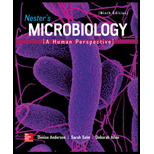
Nester's Microbiology: A Human Perspective
9th Edition
ISBN: 9781259709999
Author: Denise G. Anderson Lecturer, Sarah Salm, Deborah Allen
Publisher: McGraw-Hill Education
expand_more
expand_more
format_list_bulleted
Concept explainers
Question
Chapter 16, Problem 8SA
Summary Introduction
To review:
The examples of a neurotoxin, an enterotoxin, and a cytotoxin.
Introduction:
Toxins are the poisonous substance that is produced by bacteria that can kill or adversely affect the other organisms. Toxins are of mainlytwotypes based on the secretion: exotoxins, which are secreted outside the body of pathogen and endotoxins, which are secreted inside the body of pathogens. A neurotoxin, enterotoxin, and cytotoxins are the examples of exotoxins.
Expert Solution & Answer
Want to see the full answer?
Check out a sample textbook solution
Students have asked these similar questions
What is the structure and function of Eukaryotic cells, including their organelles? How are Eukaryotic cells different than Prokaryotic cells, in terms of evolution which form of the cell might have came first? How do Eukaryotic cells become malignant (cancerous)?
What are the roles of DNA and proteins inside of the cell? What are the building blocks or molecular components of the DNA and proteins? How are proteins produced within the cell? What connection is there between DNA, proteins, and the cell cycle? What is the relationship between DNA, proteins, and Cancer?
Why cells go through various types of cell division and how eukaryotic cells control cell growth through the cell cycle control system?
Chapter 16 Solutions
Nester's Microbiology: A Human Perspective
Ch. 16 -
1. Describe three types of symbiotic...Ch. 16 -
2. Describe two situations that can lead to...Ch. 16 -
3. How are acute, chronic, and latent infections...Ch. 16 - Prob. 4SACh. 16 - Describe the four general mechanisms by which...Ch. 16 - Describe two mechanisms that bacteria use to...Ch. 16 - Explain how a capsule can allow an organism to be...Ch. 16 - Prob. 8SACh. 16 -
9. Describe two mechanisms a virus might use to...Ch. 16 -
10. How do Schistosoma species avoid antibodies?
Ch. 16 - Prob. 1MCCh. 16 - Prob. 2MCCh. 16 - The C5a peptidase enzyme of Streptococcus pyogenes...Ch. 16 - Prob. 4MCCh. 16 - Prob. 5MCCh. 16 - Prob. 6MCCh. 16 - Prob. 7MCCh. 16 - Prob. 8MCCh. 16 - Prob. 9MCCh. 16 -
10. Which of the following statements about...Ch. 16 - A group of smokers suffering from Staphylococcus...Ch. 16 - Prob. 2ACh. 16 - Prob. 1CTCh. 16 - Prob. 2CT
Knowledge Booster
Learn more about
Need a deep-dive on the concept behind this application? Look no further. Learn more about this topic, biology and related others by exploring similar questions and additional content below.Similar questions
- In one paragraph show how atoms and they're structure are related to the structure of dna and proteins. Talk about what atoms are. what they're made of, why chemical bonding is important to DNA?arrow_forwardWhat are the structure and properties of atoms and chemical bonds (especially how they relate to DNA and proteins).arrow_forwardThe Sentinel Cell: Nature’s Answer to Cancer?arrow_forward
- Molecular Biology Question You are working to characterize a novel protein in mice. Analysis shows that high levels of the primary transcript that codes for this protein are found in tissue from the brain, muscle, liver, and pancreas. However, an antibody that recognizes the C-terminal portion of the protein indicates that the protein is present in brain, muscle, and liver, but not in the pancreas. What is the most likely explanation for this result?arrow_forwardMolecular Biology Explain/discuss how “slow stop” and “quick/fast stop” mutants wereused to identify different protein involved in DNA replication in E. coli.arrow_forwardMolecular Biology Question A gene that codes for a protein was removed from a eukaryotic cell and inserted into a prokaryotic cell. Although the gene was successfully transcribed and translated, it produced a different protein than it produced in the eukaryotic cell. What is the most likely explanation?arrow_forward
- Molecular Biology LIST three characteristics of origins of replicationarrow_forwardMolecular Biology Question Please help. Thank you For E coli DNA polymerase III, give the structure and function of the b-clamp sub-complex. Describe how the structure of this sub-complex is important for it’s function.arrow_forwardMolecular Biology LIST three characteristics of DNA Polymerasesarrow_forward
arrow_back_ios
SEE MORE QUESTIONS
arrow_forward_ios
Recommended textbooks for you
 Human Heredity: Principles and Issues (MindTap Co...BiologyISBN:9781305251052Author:Michael CummingsPublisher:Cengage Learning
Human Heredity: Principles and Issues (MindTap Co...BiologyISBN:9781305251052Author:Michael CummingsPublisher:Cengage Learning Concepts of BiologyBiologyISBN:9781938168116Author:Samantha Fowler, Rebecca Roush, James WisePublisher:OpenStax College
Concepts of BiologyBiologyISBN:9781938168116Author:Samantha Fowler, Rebecca Roush, James WisePublisher:OpenStax College


Human Heredity: Principles and Issues (MindTap Co...
Biology
ISBN:9781305251052
Author:Michael Cummings
Publisher:Cengage Learning

Concepts of Biology
Biology
ISBN:9781938168116
Author:Samantha Fowler, Rebecca Roush, James Wise
Publisher:OpenStax College


